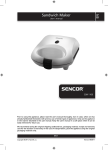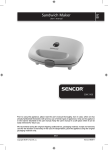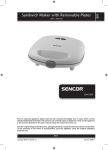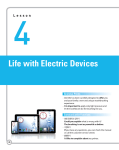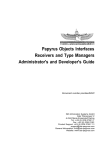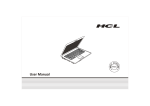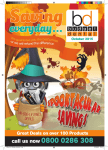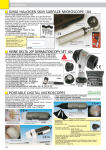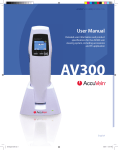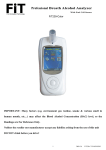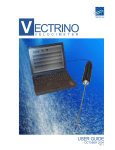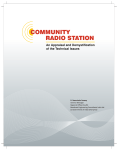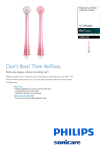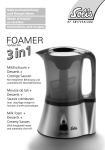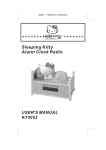Download Oral Healthcare for the Dyspraxic Child
Transcript
Oral Healthcare for the Dyspraxic Child A Guide for Parents, Specialists and Healthcare Professionals by Anna Vaughan Introduction Welcome, and thank you for taking interest into my resource package. My name is Anna Vaughan and I am currently studying for a Diploma in Dental Hygiene and Dental Therapy at The Barts and The London School of Medicine and Dentistry. For part of the course we have to complete a special needs project. I decided to base my project on children with dyspraxia and their oral health care needs. I carried out my own research via literature, attending conferences / clinics and discussions with healthcare professionals. From the results of my research I was able to collaborate the information and produce this resource package. This resource pack has been designed to; educate parents and professionals of dyspraxic children on their oral health care needs, encourage effective tooth brushing and hopefully make it a more fun and enjoyable experience for the child. Overall I hope that I have achieved a valuable resource that will benefit parents, healthcare professionals and the dyspraxic child. Thank you again, and enjoy! Anna Vaughan Contents 1. Prevention advice: Page numbers • What is tooth decay? • How to prevent tooth decay. • What is gum disease? • How to prevent gum disease. • What is dental erosion? • How to prevent dental erosion. • Accidents and injuries. • Toothbrushing technique. • Fluoride • Fissure Sealants. • Visiting the dentist. 1 2 3 4 5 5 6 6-7 8 9 9 2. Products for the dyspraxic child. 10-14 3. Modifying a manual toothbrush. 15-17 4. Pictures on toothbrushing for the dyspraxic child. 18-20 5. Toothbrushing timetable chart for the dyspraxic child. 21-22 Anna Vaughan Prevention advice “What is tooth decay?” Tooth decay is decalcification of the tooth tissue. This means that the minerals in our teeth are being dissolved away. Tooth decay occurs when the sticky germs in our mouths (known as plaque) convert sugars from our diet into acid. Inside our mouths we are always forming plaque. The normal level of plaque ph in our mouths is arround 5.5. However when we have sugar this level of plaque ph falls and we have an acid attack.These acids cause the tooth tissue to dissolve away. As plaque is so sticky it keeps these acids in contact with the teeth for a long amount of time. After many acid attacks the tooth structure can break down forming a hole also known as a cavity. A diagram showing the tooth decay process. Frequent acid attacks cause the teeth to stay in this low ph level for a longer amount of time. It is therefore not so much the amount of sugar that we eat but how often we eat it that causes tooth decay.The watery fluid in our mouths known as saliva helps to protect our teeth. Saliva is naturally alkaline and helps reduce the acid on the teeth. This however can take up to two hours, thus frequent snacking on sugary foods and drinks will prevent the saliva from protecting the teeth. If tooth decay is left untreated it will in time reach the deeper tooth tissues and cause toothache and infection. Anna Vaughan 1 “How do I help prevent tooth decay?” • Ensure the child’s teeth are brushed twice a day (last thing at night and on one other occasion) for at least two minutes. If the child struggles with manual dexterity they may benefit from a modified toothbrush, see page 15. They may also require more time for brushing. • The child should have supervised brushing up to the age of 7 years or until they can brush well themelves. • Use a medium textured toothbrush with a small head so the child has better access to the back teeth. • Use a toothpaste containing fluoride. Fluoride strengthens the teeth and helps reduce the risk of tooth decay. See section ‘What is fluoride’ page 8 for fluoride amounts as these vary with age. • When possible encourage the child to clean in-between the teeth daily using interdental cleaners. However it is more important to achieve effective brushing twice a day, so If cleaning between the teeth is not possible or too difficult focus the child’s efforts on the toothbrushing. • Sugars should not be consumed more than four times a day. • The frequency and amount of food and drinks containing sugar should be reduced, and when consumed limited to mealtimes only. Try to encourage dentally safe snacks and drinks between meals. Fruit, vegetables, cheese, water and milk are much healthier because they contain natural sugars and are less likely to cause tooth decay. • Be aware that some childrens medications contain sugar, if possible seek an alternative. • Attend the dentist regularly for oral examinations. Take advice from your dentist about protective treatments such as fluoride supplements and fissure sealants. 2 Anna Vaughan “What is gum disease?” Gum disease is also known as gingivitis. Gum disease is caused by germs in plaque. When the plaque forms around the gum margins and remains there for long periods of time they irritate the gums, causing them to become swollen. This swelling weakens the gums and they bleed easily, usually during brushing, flossing or even biting into hard foods.There is usually little or no pain with early gum disease, because of this many people ignore the early warning signs. A healthy gum should appear salmon pink in colour and should not bleed. The first important sign of gum disease is bleeding from the gums as this shows where the disease is present. Many people mistake the bleeding as brushing too hard but in many cases it is due to the swelling within the gums. In order to reduce the bleeding the plaque needs to be removed. This means the areas that are bleeding actually require more time and effort with tooth brushing. Early gum disease is reversible; therefore with a good oral health care routine the gums can return to health. However if left untreated it is likely to worsen. In severe cases such as advanced gum disease it can cause the gums to recede and damages the tissues that hold the teeth in place. At this stage the condition is irreversible and if left can cause the teeth to become mobile and in time cause tooth loss. Advanced Gum Disease Healthy Gums Anna Vaughan 3 “How do I prevent gum disease? • Ensure the child gets into the routine of brushing their teeth twice a day. (Last thing at night and on one other occasion.) Try encouraging the child to use the timetable chart and tooth brushing pictures included within this pack to help aid with brushing and create a routine. • Gums that bleed require more attention with the toothbrush so ensure these areas are cleaned really well. • The child should have supervised brushing up to the age of 7 years, or until they are able to brush well themselves. If the child really struggles try getting them to brush first and then check the brushing after using disclosing tablets. Disclosing tablets stain plaque a bright colour so it can be easily seen and then brushed away. • Encourage cleaning in-between the teeth with floss or an interdental cleaner. However if this is not possible or too difficult concentrate the child’s efforts on brushing. • Attend the dentist regularly for professional cleaning’s and oral exams. 4 Anna Vaughan “What is dental erosion?” Dental erosion is the gradual wearing away of the enamel on the teeth (enamel is a hard coating on teeth which helps protect them). It is caused by acid attacking the surfaces of the teeth, but this time germs from plaque do not produce the acids. Instead these acids usually come from food and drink that we have such as fruit juices, fizzy drinks and squashes - even the sugar-free varieties. Dental erosion can result in sensitive teeth and pain. Although the enamel cannot grow back it doesn’t usually require treatment. However in severe cases of dental erosion the dentist may protect the teeth with a filling. “How can I help prevent dental erosion?” Consuming acidic food and drinks frequently is the main cause of tooth erosion. It is the frequency of acidic food and drinks rather than the amount that effects the tooth. • Keep squashes, fizzy drinks, natural fruit juices, to a minimum. • Avoid acidic and sugary food and drinks between meals or before bedtime. Whilst we sleep our saliva that protects our teeth is reduced, therefore the teeth will be coated in acid for a longer period of time. • Encourage the child to drink dentally safe drinks such as water and milk for in-between meals and have the sugary drinks during mealtimes only. • If you want to try to wean your child off sugary drinks such as squashes try diluting them gradually over a period of time so that less squash is consumed. • Help to protect against tooth decay and erosion by finishing a meal with an alkaline food such as milk or cheese. This will reduce the acid in your child’s mouth. • Avoid brushing teeth straight after having acidic drinks as this will encourage more minerals to be lost from the teeth, wait at least half an hour before brushing. Anna Vaughan 5 “What do I do if the child injures their tooth?” Accidents resulting in injury to children’s teeth are very common. With any injury to the teeth you should contact your dentist as soon as possible so that the dentist can advise on treatment if necessary. If the child is in pain from a broken, cracked or chipped tooth, you should visit the dentist as soon as possible. Try to keep any part of the tooth that has broken off and take this with you to the dentist. If the tooth has been completely knocked out of the mouth contact the dental practice and go immediately. Handle the tooth as little as possible, do not wipe and store in a cup of fresh milk until you get to the dentist. It may be possible to have the tooth placed back into the child’s mouth. “How should I brush the child’s teeth?” The child should start having their teeth brushed as soon as their first tooth has erupted (usually around six months.) When the child is old enough they should be taught how to brush their teeth and need supervision until they can brush well themselves. Tooth brushing requires good manual dexterity and the dyspraxic child may require much more time and practice to master the skill. Encourage the child to brush their teeth first and then complete the brushing for them until they can do it themselves. The child may find it easier to be seated during brushing. Allow extra time at weekends to practice brushing which will help improve the child’s brushing technique. Supervised brushing should be carried out in front of a mirror with the parent /carer standing behind and slightly to the side of the child. This allows the child to visually see what areas need brushing and makes teaching the child much easier. Ensure adequate time is made in the mornings and evenings for tooth brushing. See page 7 for supervised brushing technique. 6 Anna Vaughan “How do I brush the child’s teeth and gums correctly?” 1 Place the toothbrush bristles along the gum line at a 45-degree angle. Bristles should contact both the tooth surface and the gum line to remove plaque from the teeth and gums effectively. 2 Gently brush each tooth individually, start with the outer tooth surfaces using a gentle circular movement encouraging the bristles to clean in between the teeth and into the gum margins. Move the brush to the next tooth and repeat. 3 Once all the outer surfaces have been cleaned start brushing the insides of the teeth maintaining a 45-degree angle with bristles contacting the tooth surface and gum line. Carry on brushing in the circular motion along all of the inner tooth surfaces. 4 When brushing the inside of the lower teeth tilt brush vertically behind the front teeth making several up & down strokes using the front half of the brush. 5 Once all the insides of the teeth are clean place the brush against the biting surface of the teeth & use a gentle back & forth scrubbing motion. When all the surfaces of the teeth have been cleaned, gently brush the tongue from back to front. Anna Vaughan 7 “What is Fluoride and what are its benefits?” Fluoride is a natural mineral and is contained in many toothpastes and mouthwashes. Fluoride combines with the tooth’s enamel to strengthen it thus reducing the risk of tooth decay. Fluoride is also present in some water supplies (You can find out if your water contains fluoride by contacting your local water suppliers.) • Always use a toothpaste containing fluoride. Children under 3 years only require a smear amount of toothpaste on the brush, children over 3 years should use a pea-size amount of toothpaste for brushing. • The amount of fluoride contained in toothpastes vary. Always check that you are using the correct amount. The fluoride amounts are measured in ‘ppmF’ (parts per million Fluoride) and will be printed on the side of the toothpaste. Children under 3 years should use a toothpaste containing no less than 1000ppm of fluoride. Children over 3 years should use a toothpaste containing 1350ppm - 1500ppm of fluoride. • Fluoride mouthwashes can also be used for children aged 7 years and over. Mouthwashes should be used on a seperate occasion to toothbrushing (for example: when get home from school) as the fluoride in the toothpaste already helps to protect the teeth. • Encourage the child to ‘spit out’ the toothpaste when finished brushing and avoid the child from swallowing the toothpaste. • Discourage the child from rinsing after brushing as this washes away the fluoride that helps protect the teeth. Instead encourage them to spit out the toothpaste. 8 Anna Vaughan “What are fissure sealants?” Another way to help protect teeth from tooth decay is the application of fissure sealants. These are a plastic coating, that are applied onto the grooves and fissures on the biting surfaces of the teeth. Fissure sealants help protect these vulnerable areas from tooth decay by preventing the access of plaque and plaque acids. Fissure sealants are quick and painless to apply and do not require any drilling. The dentist cleans the tooth with a special acid, washes and dries the tooth then applies the plastic coating; this is then set using a special light. Fissure sealants are a good way for preventing tooth decay and can last for several years. However they do require visits to the dentist to check that they have not worn through or chipped. Children with fissure sealants will still need to brush their teeth with fluoride toothpaste. “When should I start taking the child to the dentist?” It’s a good idea to take the child with you when you go for your own routine dental check ups, even when they are too young to have teeth. This helps them to become familiar with the people and the surroundings at the dental surgery. Regular check ups allows the dentist to count how many teeth have erupted and spot any early signs of tooth decay or gum disease. Quick, painless check-ups like this help to encourage good co-operation and compliance when the child is older.The dentist will recommend check-ups at intervals suitable for the child. Anna Vaughan 9 Products available for the Dyspraxic child. There are many oral health care products available for children. Dyspraxic children’s likes and dislikes vary considerably, so find out what works best for the child. As a general rule always ensure that the toothpaste and mouthwashes that you choose contain the correct amount of fluoride to help protect teeth from decay. Also ensure the toothbrush that you choose has a small head to make brushing around the back teeth easier. There are many toothbrushes pictured in this section however similar own brand brushes are just as suitable. Tooth brushing timers are a great aid for showing a child visual representation of the time required to brush teeth. Another way is to play their favourite music during tooth brushing. Mirrors enable the parent and child to examine the teeth and other structures within the mouth. They are especially good for checking areas in the mouth that have been missed after brushing. 10 Anna Vaughan Toothbrushes. The Oral-B Stages 1 toothbrush can be your child’s very first toothbrush. Designed for young children aged from 424 months. The Oral-B Stages 2 toothbrush is designed for children aged 2-4 years. A narrow brush head is much easier to brush around the child’s small mouth. The easy-grip chunky handle has a textured surface designed to help the child learn to brush. Disney’s Mickey Mouse and friends or Winnie the Pooh and friends characters in four fun colour combinations may help encourage the child to brush. The Oral-B Stages 3 toothbrush is for children aged 5-7 years. All the first teeth will be present, and permanent teeth are beginning to arrive. The bristles are targeted for the hard-to-reach back teeth. It also has a large squish grip handle, which is great for hands still learning to brush. Oral B stages 4 are designed for children aged 8 years and over. Children at this age have a mixture of permanent and first teeth. Anna Vaughan 11 Aquafresh has a range of toothbrushes specially designed for children. The large grip on the handles helps improve brushing control for small hands. They are also available in a wide choice of colourful characters. These brushes have a flexible neck for those children who maybe brushing too hard which helps absorb excessive brushing pressure. Tepes have a wide range of toothbrushes. Tepe brushes have a small tapered head with compact bristles for efficient cleaning. These are also suitable for individuals with gag reflexes when cleaning hard-to-reach surfaces. Some Dyspraxic children may find electric toothbrushes much easier to manipulate around the teeth. Fun characters may also help motivate and encourage a child to brush their teeth. If your child dislikes using electric toothbrushes try using a modified toothbrush - see section - ‘Modifying a manual toothbrush’ page 15. Interdental cleaners. Flossing with the dyspraxic child may proove difficult. For those children who can floss try using a tape, which is easier to get between the teeth.The floss should be inserted between the teeth and moved down the tooth and gently below the gum line. This should be repeated for each tooth. If flossing is not possible concentrate on effective toothbrushing twice a day as this is more important. 12 Anna Vaughan There are also flossing products with handles that can help children that really struggle with flossing. The long handle design allows easy access to difficult to reach areas, making flossing between the back teeth much easier than manual flossing. In between brushes are also available to clean in between the teeth. Long handled designs may help with cleaning back teeth. Your child may prefer using these and find it easier than flossing. Toothpastes. It is better to start your child brushing with a mint toothpaste as transition onto adult toothpastes can proove difficult. However if the child strongly dislikes mint toothpaste try using childrens flavoured toothpastes. Tesco’s have a range of flavours such as strawberry ice-cream and bannana milkshake flavour which also cost under £1. These contain 1450ppm of fluoride so are designed for children aged 3 years and over. Holland and Barratt also have a range of flavoured toothpastes but always check that you are using the correct amount of flouride for the child’s age. Punch and Judy strawberry flavoured toothpaste is designed for children aged up to three years and contains1056ppm fluoride. Anna Vaughan 13 ‘Toms natures’ fluoride toothpaste has natural ingredients and pure fruit flavours. This contains 1000ppm fluoride so should be used for childen under 3 years. Available at goodnessdirect.co.uk Toothpaste dispensors. Toothpaste tube squeezers can help aid with; dispensing paste onto a brush, reduces waste and prevents the ‘roll up’ technique that the dyspraxic child may find difficult. There are also many toothpastes now available with a pump device so see which works best for the child. Mouthwashes. Mouthwashes can be used for children aged 7 years and over. Choose a mouthwash containing fluoride and use on a seperate occasion to toothbrushing. Aquafresh Mouth Whoosh is an antibacterial mouthwash specifically designed for children which also contains fluoride. Disclosing tablets. Disclosing tablets stain the plaque a bright colour. Use disclosing tablets on some brushing occasions. These are a great aid to highlight areas that have been missed with the toothbrush. This can make brushing more fun for the child as they can brush away the colour. 14 Anna Vaughan Modifying a manual toothbrush. 1 2 3 Foam balls are a great aid to help with manual dexterity. Create a small hole in the centre of the ball and gently insert the toothbrush. This allows the child to have a better grasp of the brush and make manipulation of the toothbrush easier. 1 2 3 Foam used for pipe insulation covers can also be used by adapting twice around the brush and supported with an elastic band. This increases the size of the grip making grasp around the brush much easier. Anna Vaughan 15 1 2 3 Elastic bands can be used to help the positioning and grasp of the fingers around the brush. This aid can be easily produced by creating two small holes at the top and bottom of the toothbrush handle. A piece of elastic can then be threaded through and fastened in place. 1 2 3 Silicone rubber can be moulded around the handle of the toothbrush. It can be shaped exactly to the child’s grip and allowed time to set. The child then has a toothbrush that is specifically moulded to their own grip making toothbrushing more comfortable. 16 Anna Vaughan 1 2 3 These ‘tepe molar grips’ are avialable from molar dental supplies and are specially designed to enhance grip on the toothbrush. They easily slide onto the brush. However these grips only fit the tepe and sensodyne toothbrushes. 1 Long handles can be fastened onto manual toothbrushes which may help a child that really struggles with both gross and fine motor movements. Anna Vaughan 17 Tooth Brushing Pictures for the Dyspraxic Child 1 OTHBRUSHING. TRAFFIC LIGHT TO the to othpaste onto Start by squeezing picllow the coloured fo w no h, us br ur yo ess the task. Gently pr tures to complete a the to oth an d use the brush against h et n to get your te small circular motio EEN MEANS GO squeaky clean!! GR rst. ur bottom teeth fi Start brushing yo 2 3 4 5 6 7 18 8 9 You are half way through brushing, now turn over your brush and start cleaning the top teeth - keep going until the traffic light turns red. 1 2 19 3 4 5 6 7 8 9 nishe d u have now fi Well done! Yo teeth l have clean il w u o y , g in brush ow place ms! You can n u g y h lt a e h rt d an othbrush cha to r u o y n o r a sticke go o d work! Keep up the 20 SUNDAY SATURDAY FRIDAY THURSDAY WEDNESDAY TUESDAY MONDAY WEEK 1 WEEK 2 WEEK 3 WEEK 4 Tooth Brushing Timetable Chart. SUNDAY SATURDAY FRIDAY THURSDAY WEDNESDAY TUESDAY MONDAY WEEK 5 WEEK 6 WEEK 7 WEEK 8 Brush your teeth and gums twice a day to keep the nasty bugs away. Place a sticker each time you brush, and please remember, do not rush. Anna Vaughan


























